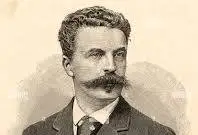“The Terror” – Guy de Maupassant
“The Terror” by Guy de Maupassant is a short story that delves into themes of fear, loneliness, and existential dread. It follows the inner turmoil of the narrator, who experiences an intense fear of being alone at night. The story explores how fear can stem from within, becoming more terrifying than any external threat.
Introduction about the Author:

Guy de Maupassant (1850–1893) was a renowned French author, celebrated as one of the greatest short story writers in literary history. Born in Normandy, France, Maupassant was known for his keen observation of human nature, vivid storytelling, and mastery in exploring the darker aspects of the human psyche, including fear, despair, and isolation.
Maupassant’s writing often reflected the themes of realism and naturalism, portraying everyday life with stark realism while also delving into psychological complexities. Many of his stories, including The Terror, reveal his fascination with mental anguish and irrational fears, influenced partly by his own experiences with illness and depression.
In his lifetime, he wrote over 300 short stories, six novels, travel journals, and essays. His famous works include The Necklace, Boule de Suif, and The Horla. Maupassant’s style is marked by an economy of language, with simple yet powerful prose that precisely captures emotions and experiences.
He struggled with mental health issues towards the end of his life and passed away at the age of 42, but his works remain widely read and influential, continuing to inspire readers and writers around the world.
Summary of the story:

The narrator starts by recounting a seemingly ordinary day. As the night approaches, he begins to feel a growing sense of unease and fear, though there is no logical reason for it. He describes how the darkness seems to press upon him, making him feel isolated and vulnerable. He is terrified of the silence and the thought of being alone in his house.
In an attempt to escape his overwhelming fear, the narrator frantically goes out into the streets, seeking comfort in human presence. This behavior reveals the deeper psychological layers of the story, highlighting how fear is often irrational and rooted in the human psyche’s need for companionship. The narrator’s terror is not tied to any particular event or danger—it is a nameless, all-consuming dread.
Themes:
- Fear and Anxiety – Maupassant captures the essence of fear as a deeply personal experience that can arise without any external threat.
- Loneliness – The story emphasizes the fear of being alone and how isolation can heighten one’s vulnerability.
- Existential Dread – The narrator’s experience hints at the human fear of meaninglessness and the unknown, reflecting an existential crisis.
Style:
Maupassant’s writing is atmospheric and introspective, drawing readers into the narrator’s troubled mind. The story reflects the naturalist style typical of Maupassant, where emotions and psychological states are explored in great detail, making the reader feel the intensity of the protagonist’s emotions.
“The Terror” is a brilliant exploration of how fear can become a powerful force in the absence of rationality, demonstrating Maupassant’s mastery in portraying the complexities of the human mind.
Character Analysis:

- The Narrator
- Personality: The narrator seems to be an ordinary person but struggles with intense anxiety and fear. His personality shows a deep sensitivity to loneliness and the unknown.
- Inner Conflict: Much of the story revolves around his battle with irrational fear. Despite recognizing that there is no real danger, he is overwhelmed by a growing sense of terror, which demonstrates his struggle with his inner mind.
- Fear of Solitude: He experiences a strong aversion to being alone, highlighting his dependence on human presence for comfort. This suggests an underlying fear of isolation, which becomes all-consuming when he is left on his own at night.
- Behavior: As the night progresses, the narrator behaves irrationally, fleeing from his home and seeking refuge in the presence of other people. His actions symbolize how overpowering fear can be, even when no external threat exists.
- Existential Crisis: The narrator’s fear can be interpreted as a manifestation of existential dread—his terror may stem from a fear of emptiness, death, or meaninglessness. This gives the character a tragic depth, showing how such feelings can paralyze someone.
Through the narrator, Maupassant offers a profound reflection on the human condition, illustrating how fear, loneliness, and the unknown can have a grip on the mind, making even the most rational individuals succumb to irrational behavior. The absence of other characters emphasizes the narrator’s isolation, deepening the story’s psychological intensity.
Do Follow us on YouTube: – www.youtube.com/@StudyEnglishLiterature
